#IAF Sukhoi Su 30MKI
Explore tagged Tumblr posts
Text
#100 more K9 Vajra howitzers#Cabinet Committee on Security#IAF Sukhoi Su-30MKI#Indian Air Force#Indian Air Power#Indian Army#Indian Defence#Make In India
0 notes
Text
Unleashing Power and Precision: A Comprehensive Guide to Indian Air Force Fighter Planes
Introduction
The Indian Air Force (IAF) stands as a symbol of strength and prowess in the vast skies above the subcontinent. Over the years, it has acquired a formidable fleet of fighter planes, each a marvel of engineering and a testament to the nation's commitment to aerial defense. In this blog post, we will delve into the Indian Air Force Fighter Planes list, exploring the capabilities and features that make them the guardians of the Indian airspace.
Evolution of the Indian Air Force
The IAF has come a long way since its inception in 1932. From its humble beginnings with obsolete biplanes, the force has evolved into a modern and technologically advanced air arm. The backbone of the IAF's aerial might lies in its fleet of fighter planes, which have played a crucial role in safeguarding the nation's sovereignty.

Key Considerations in Fighter Plane Selection
Before diving into the list of Indian Air Force fighter planes, it's essential to understand the criteria that govern the selection of these aerial assets. The IAF considers factors such as range, speed, agility, firepower, and electronic warfare capabilities when choosing its fighter planes. These aircraft are designed to operate in diverse environments, from the scorching deserts of Rajasthan to the high-altitude regions of the Himalayas.
Indian Air Force Fighter Planes List
Sukhoi Su-30MKIThe Su-30MKI, a Russian-origin aircraft, has become the backbone of the IAF's fighter fleet. With its twin-engine design, long-range capabilities, and advanced avionics, the Su-30MKI is a versatile and lethal platform. It can carry a variety of air-to-air and air-to-ground missiles, making it a potent force in both aerial combat and ground attacks.
Dassault RafaleThe Dassault Rafale, a French-made multirole fighter, represents the cutting edge of modern military aviation. Its advanced radar systems, electronic warfare capabilities, and precision-guided munitions make it a force to be reckoned with. The Rafale has significantly bolstered the IAF's strategic capabilities, providing an edge in both air superiority and ground attacks.
MiG-29The MiG-29, a stalwart in the IAF's fleet, has undergone various upgrades to enhance its performance. Known for its agility and speed, the MiG-29 is a fourth-generation fighter that can hold its own in air-to-air combat. Its role in providing air defense and escorting other aircraft adds a layer of versatility to the IAF's operations.
TejasDesigned and manufactured indigenously, the Light Combat Aircraft (LCA) Tejas is a point of pride for India's aerospace industry. With its lightweight design and advanced avionics, the Tejas is tailored for maneuverability. As the IAF continues to induct Tejas variants, it marks a significant stride toward self-reliance in defense production.
JaguarWhile originally designed for ground attack missions, the Anglo-French SEPECAT Jaguar has been adapted for various roles within the IAF. Equipped with a combination of precision-guided munitions and a formidable gun, the Jaguar serves as a potent asset in both air-to-ground and anti-ship operations.
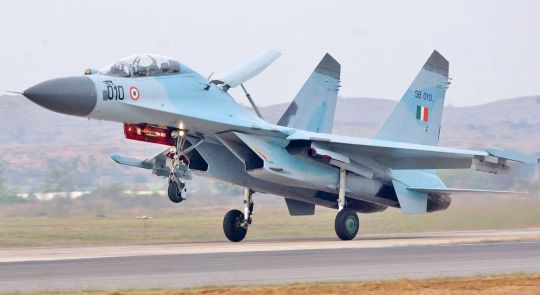
Strategic Importance of Fighter Planes
The role of fighter planes extends beyond just engaging in dogfights. They serve as a critical component of national defense, acting as a deterrent and providing a strategic advantage. The IAF's fighter planes play a pivotal role in ensuring air superiority, conducting reconnaissance, and delivering precision strikes when needed.
Challenges and Future Developments
While the IAF's fleet of fighter planes is formidable, it is not without challenges. The need for continuous upgrades, technological advancements, and the emergence of new threats require constant vigilance and adaptation. The IAF is actively pursuing modernization initiatives, including the development of next-generation fighter aircraft, to maintain its edge in an ever-evolving geopolitical landscape.
Conclusion
In conclusion, the Indian Air Force's fighter planes stand as a testament to the nation's commitment to aerial defense. From the iconic MiG-21s of yesteryears to the state-of-the-art Rafales and Tejas of today, each aircraft in the IAF's inventory plays a crucial role in securing the skies above India. As the nation continues to invest in indigenous defense production and embraces cutting-edge technology, the future of the IAF's fighter fleet looks promising, ensuring that the Indian skies remain safeguarded for generations to come.
3 notes
·
View notes
Text
2nd day of Rehearsal of SURYA KIRAN & SUKHOI Su-30MKI at Marine Drive, Mumbai
12-01-2024 from 12 pm to 1 pm.

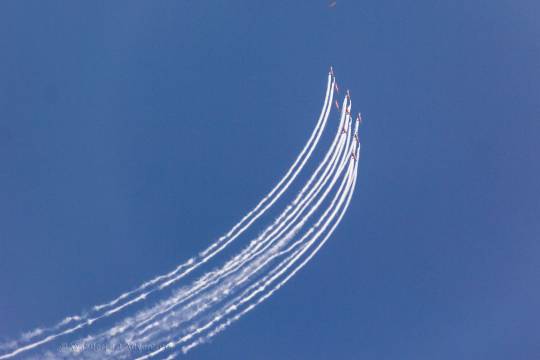

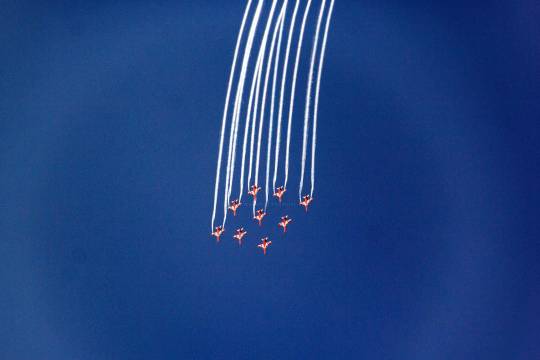
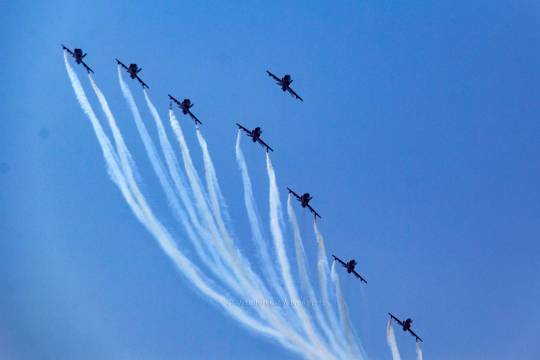

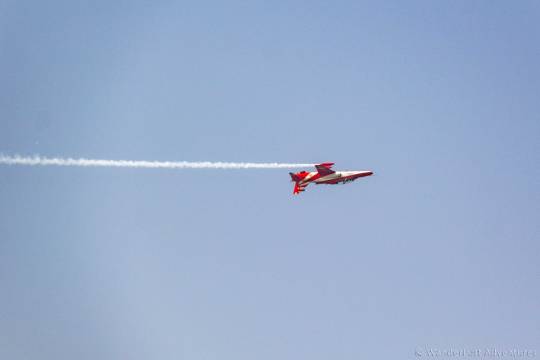

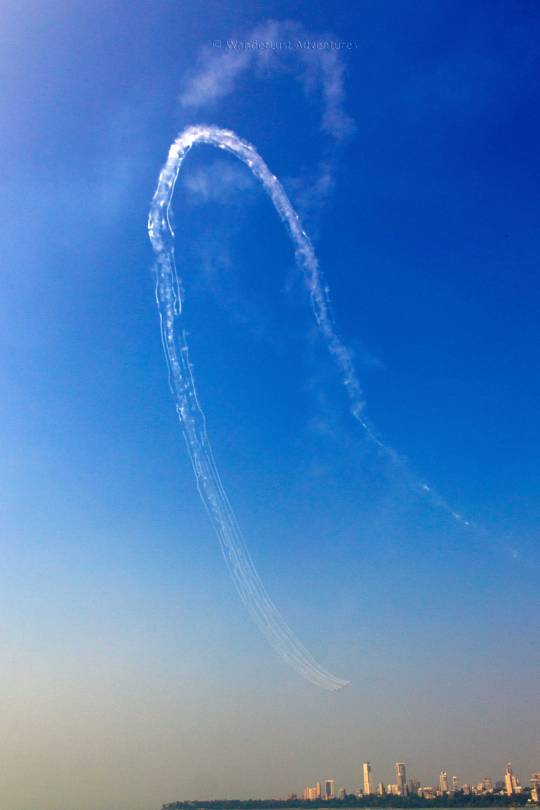
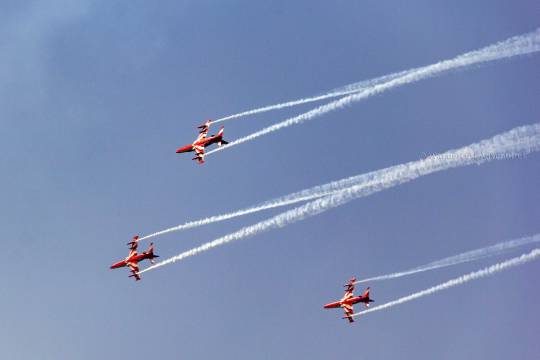
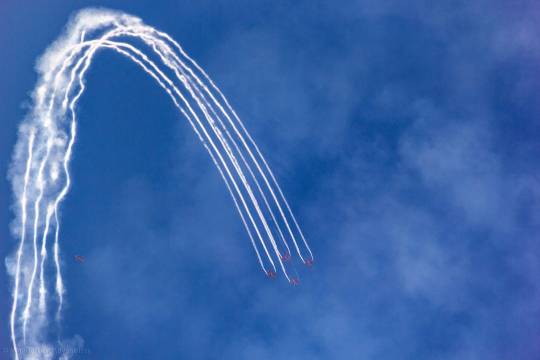
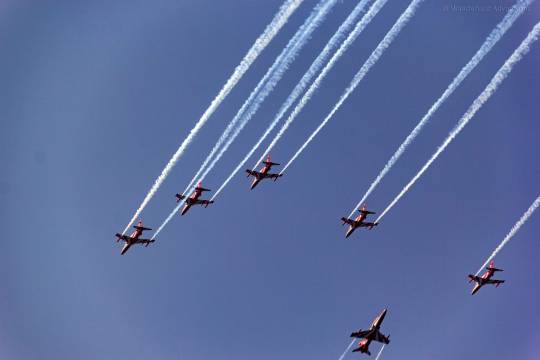
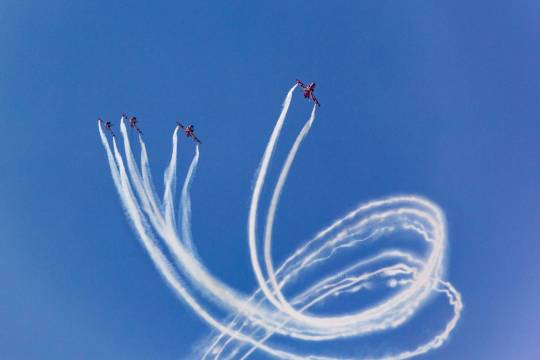

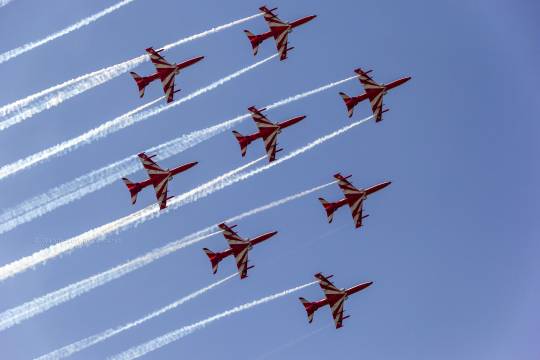



Love You INDIAN AIR FORCE - IAF - SURYA KIRAN AEROBATICS TEAM (SKAT) - SUKHOI
And this was still the rehearsal! The grand finale happens on 13th and 14th January 2024 at Marine Drive, Mumbai. Don't miss this air show for anything. It is worth. Salute to our Indian soldiers, pilots and navy.
See the rehearsal of this air show dated 11 Jan 2024 of Surya Kiran and Sukhoi here.
Check the same Mumbai Air Show's third day from Girgaum Chowpatty.
Free fall of Sukhoi Su-30MKI & the beautiful flower it makes in the sky!
#Surya Kiran Aerobatic Team#Surya Kiran#SuryaKiran#Red and White#Fighter jets#jets#Aviation#original photography on tumblr#Mumbai#Marine Drive#Air Show#Airshow#Sukhoi#Contrails#Aircrafts#Aeroplanes#Aerobatics#aerial exercises#Indian Air Force#IAF#India
2 notes
·
View notes
Text
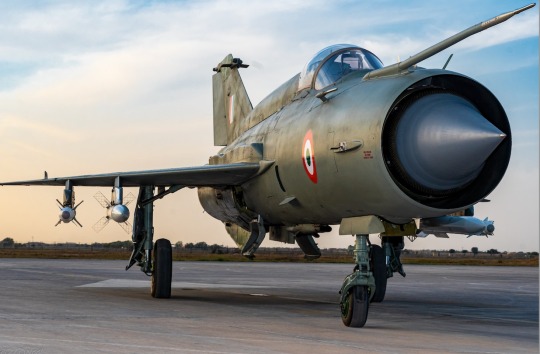
Still dependent on Russia, India exchanges its MiG-21 for the Su-30 MKI
The Number 4 Squadron of the Indian Air Force was converted from Mig-21 fighters to Su-30 MKI, continuing to depend on Russia since the Soviet era.
Fernando Valduga By Fernando Valduga 11/03/2023 - 12:30 in Military
Indian Air Force (IAF) pilots are ceasing to fly on the MiG-21 jets and moving to the Su-30MKI, with IAF Squadron Number 4 on October 30 performing the last out of the supersonic fighter that has been in service for 60 years.
The formal induction of the Su-30MKI took place on the same day, joining the MiG-21 in its final overflight.

The IAF depends on Russian defense companies for Su-30 MKI spare parts and publicly expressed difficulties with these suppliers in February 2022, during the large-scale invasion of Ukraine, as sanctions on Russia led to delivery failures.

Even with the flourishing of its partnership with the US, India remains a long-term strategic partner of Russia. The relationship with Russia in defense matters has a deep history and is necessary to maintain the Indian military platforms that, in many cases, date back to the Soviet era.
The decision to phase out the MiG-21 in favor of the Su-30 MKI and LCA fighters developed in the country was announced in 2011, when 476 jets in the fleet of 946 MiG-21 aircraft were lost in accidents over the decades. Initially scheduled for 2017, the replacement is still in progress, with two MiG-21 squadrons still in operation.
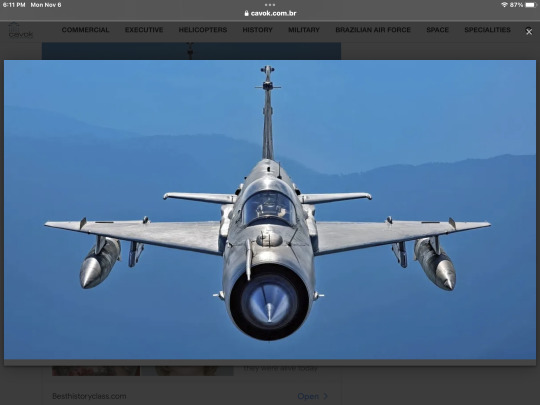
The MiG-21 was the first IAF supersonic jet, put into service in 1963 and in operation with Squadron Number 4 since 1966. The variant of the second-generation interceptor began to be delivered in 1964 and was used with great effect in conflicts with Pakistan in the periods of 1965 and 1971.

The Su-30 MKI was jointly designed by the Sukhoi Design Bureau and Hindustan Aeronautics Limited based on the Su-30 fighter. The MKI variant is a multifunctional combat aircraft that made its first flight in 1997. A major advance over the MiG-21 that the Su-30 MKI offers is a fly-by-wire control system.
The MiG-21 was highly maneuverable when it was first introduced, but today it is surpassed by aircraft with new avionics system.
Tags: Military AviationIAF - Indian Air Force/Indian Air Forcemig-21Su-30MKI
Sharing
tweet
Fernando Valduga
Fernando Valduga
Aviation photographer and pilot since 1992, has participated in several events and air operations, such as Cruzex, AirVenture, Dayton Airshow and FIDAE. He has work published in specialized aviation magazines in Brazil and abroad. Uses Canon equipment during his photographic work in the world of aviation.
Related news
HELICOPTERS
Black Hawk helicopters in accelerated delivery to Australia
06/11/2023 - 16:00
MILITARY
U.S. Navy receives second 'End Judgment Aircraft' Mercury updated
11/06/2023 - 2:00 PM
MILITARY
Aircraft carrier attack group USS Eisenhower arrives in the Middle East region
06/11/2023 - 12:00
MILITARY
Taiwan accelerates replacement of its F-5 with the new Brave Eagle advanced training jets
11/06/2023 - 10:00
MILITARY
South Korea plans to reduce production of KF-21 fighters
06/11/2023 - 08:46
MILITARY
US Air Force is testing the Pipistrel Velis Electro
06/11/2023 - 08:06
6 notes
·
View notes
Text
IAF Will Procure 12 More Sukhoi 30-MKI Jets from HAL
IAF Will Procure 12 More Sukhoi 30-MKI Jets from HAL
MoD orders 12 more Sukhoi 30-MKI Jets from HAL:New Delhi, December 12, 2024: In a significant move to bolster India’s air power and support the government’s ‘Aatmanirbhar Bharat’ initiative, the Ministry of Defence has signed a contract with Hindustan Aeronautics Limited (HAL) for the procurement of 12 Su-30MKI fighter jets. The deal, valued at approximately Rs 13,500 crore, includes associated…
0 notes
Text
Sukhoi Su-30MKI crashed in a farm: Wreckage scatters over 500m
0 notes
Text
Military 101: India's Super Sukhoi Project - A Possible Boost for Malaysia
The Super Sukhoi project, initiated by the Indian Air Force (IAF), is a significant upgrade program for their Sukhoi Su-30MKI fighter jets aimed to enhance the capabilities of India’s Air Force’s Sukhoi fleet. Image source: Screenshot of Malaysian Sukhoi Su-30MKM in a bunker from the 2022 Malaysian movie, Air Force: The Movie. Continue reading Military 101: India’s Super Sukhoi Project – A…
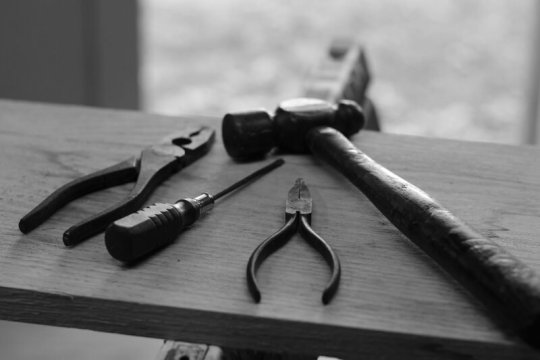
View On WordPress
0 notes
Text
Meet Avani Chaturvedi: First Woman Pilot to Fly Sukhoi Fighter Jet in Aerial Wargame Abroad
Squadron Leader Avani Chaturvedi, was part of the IAF contingent that participated in a 16-day air combat exercise with the Japan Air Self Defence Force (JASDF) at the Japanese airbase of Hyakuri. source https://zeenews.india.com/aviation/meet-avani-chaturvedi-iafs-first-woman-fighter-jet-pilot-to-fly-sukhoi-su-30mki-in-aerial-wargame-abroad-2569772.html
View On WordPress
0 notes
Text
Indian Air Force two fighter jets crash in Madhya Pradesh's Morena
Pilots being rescued from the crash site after a Su-30MKI and Mirage 2000 fighter planes crashed during an exercise, in Morena district, Saturday, Jan. 28, 2023. (PTI Photo) Bhopal: Two fighter planes of the Indian Air Force (IAF) – Sukhoi-30 and Mirage-2000 – crashed in Morena district of Madhya Pradesh on Saturday, police officials said. Morena Superintendent of Police Ashutosh Bagri…

View On WordPress
0 notes
Text
Indian Air Force two fighter jets crash in Madhya Pradesh's Morena
Pilots being rescued from the crash site after a Su-30MKI and Mirage 2000 fighter planes crashed during an exercise, in Morena district, Saturday, Jan. 28, 2023. (PTI Photo) Bhopal: Two fighter planes of the Indian Air Force (IAF) – Sukhoi-30 and Mirage-2000 – crashed in Morena district of Madhya Pradesh on Saturday, police officials said. Morena Superintendent of Police Ashutosh Bagri…

View On WordPress
0 notes
Text
जानिए कैसे हवा में दुनिया का सबसे विध्वंसक कॉम्बिनेशन है राफेल और सुखोई 30MKI
जानिए कैसे हवा में दुनिया का सबसे विध्वंसक कॉम्बिनेशन है राफेल और सुखोई 30MKI
[ad_1]

राफेल लड़ाकू बेड़े के पांच विमानों को आज भारत के लिए रवाना किया गया. राफेल (Rafale) और सुखाई 30MKI दुनिया के सबसे विध्वंसक लड़ाकू विमानों में से माने जाते हैं. सुखाई और राफेल एक बार साथ में ��परेट करना शुरू कर दें फिर किसी भ��� दुश्मन के लिए ये…
View On WordPress
#Dassault#Dassault Aviation#Dassault Aviation India#Dassault Rafale#dassault rafale india#fighter jet#IAF#IAF Sukhoi Su 30MKI#India Air Force#Indias fighter jets#Rafale#sukhoi#Sukhoi Su-30MKI#Sukhoi Su-30MKI vs Rafale
0 notes
Text






INDIAN AIR FORCE IAF - SUKHOI Su-30MKI - fighter jets - at rehearsal for the air show at Marine Drive. Clicked on 11 Jan 2024 between 12:45 to 1 pm. My experience: They seemed bigger, faster and filled with more fire power. They flew higher and their color made them inconspicuous in the haze and the sun. But the most important part was as they flew further away from us, they sounded loud, than when they were near! There were no contrails. Check out the vibrant red and white SURYA KIRAN AEROBATIC JETS here!
See the 2nd rehearsal of the air show dated 12th January 2023 of the Surya Kiran and Sukhoi here.
Check the Mumbai Air Show 2024's third day as seen from Girgaum Chowpatty.
Free fall of Sukhoi Su-30MKI and the flower of flares in the sky.
1 note
·
View note
Text
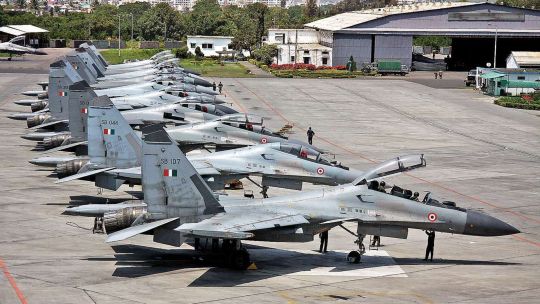
Sanctions on Russians should lead from bad to worse the maintenance of Indian Air Force jets
More than 50% of all Indian material is of Soviet or Russian origin, requiring sustained assistance from Moscow for its maintenance, repair and overhaul.
Fernando Valduga By Fernando Valduga 03/05/2022 - 10:20 am in Military, War Zones
The optimism of the Indian Air Force (IAFs) about the ability to obtain spare parts to ensure the operability of its fleet of military aircraft, despite the punitive sanctions imposed on Moscow for its invasion of Ukraine, is denied by the recurrent shortage of components that the force has always faced, even when there were no embargoes.
The deputy chief of staff of the IAF, Air Marshal Sandeep Singh, told reporters on Wednesday, March 2, that the sanctions would not greatly affect the Indiana Air Force's ability to obtain Russian spare parts and auxiliary equipment, especially for its Sukhoi Su-30MKI and MiG-29 fighters.

Su-30MKI.
“We are evaluating (the situation) and there will be difficulties, but (sanctions) should not affect us much,” said Air Marshal Singh. He, an unbelieving, added that the IAF would in no way be "significantly affected" in this regard, as its good relations with the US and Russia persevered.
The three-star officer seemed to assume, without a basis, that New Delhi's lasting strategic, defense, diplomatic and political ties with Moscow and Washington before the invasion of Ukraine would make it immune to sanctions forever, despite the US's determination to penalize Russia for its militarism.
And, like most officers in the country, Air Marshal Singh also seems to assume that jugaad (creative innovation) or, better yet, the namesake 'Indian rope trick' of 'hypnotizing' the US, the European Union and other sanctioning countries in ceding Delhi in their efforts to maintain their military trade with Russia, without hindrance.
Resorting to financial jugaad, much like what the IAF achieves on its many platforms, however, does not seem to be an option for India to circumvent sanctions. According to the New York finance website 'Investopedia', sanctions by countries or organizations "provide a political tool without military force to punish or prevent objectionable actions". He goes on to state that sanctions can cost his targets dearly, or simply that trying any sanctions breach ploy can be harmful, not only to Russia as a seller of embargoed goods, but also to India as a buyer.
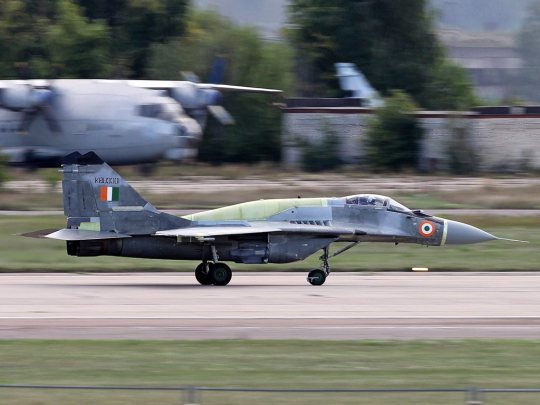
MiG-29UPG.
It also seems that Air Marshal Singh was denying the very reiteration of the IAF and the Ministry of Defense of the shortage of Russian equipment spare parts, which negatively impacted not only the IAF, but the entire army of India, for decades. More than 50% of all Indian material is of Soviet or Russian origin, requiring sustained assistance from Moscow for its maintenance, repair and overhaul (MRO) and, in some cases, even its updating.
However, these continuously delayed shortcomings and MROs persisted even during what many officers called the "good years" of India-Russia ties and were routinely highlighted by numerous parliamentary defense committees and Comptrollership and General Audit (CAG) audits. But under the recent sanctions imposed on all Russian military and related entities, India's endless problem of obtaining Russian spare parts, despite the confidence of Air Marshal Singh, promises only to get much worse if the acquisition does not cease completely.

“It is a critical issue for the IAF and it is getting harder every day, in an unlikely situation to correct for several years,” said military analyst Air Marshal V. K. ‘Jimmy’ Bhatia (retired). Sanctions on Russia, warned the former fighter pilot, will be a detrimental disadvantage in keeping Russian IAF platforms operational and may even force it to resort to inadequate purchases of "gray market" components to compensate for asset deficiencies.
Former Chief of Staff of the Indian Navy, Admiral Arun Prakash, takes an apocalyptic step further.
"Severe sanctions on Russia may eventually result in the disarmament of the Indian military due to the shortage of equipment and spare parts," he warned, blaming Indian authorities for the imminent quagmire of material hanging over the country's armed forces. “Indian politicians,” said the former navy chief, “were apparently indifferent to this crisis; the incomprehensible bureaucracy and scientists from the Defense Research and Development Organization (DRDO) were never held responsible for their inability to deliver competent weapons systems on time.”

MiG-21.
The IAF currently operates more than 410 Soviet and Russian fighters comprising a mixture of imported and licensed platforms. These included about 14 Su-30MKI 'Flanker' squadrons of about 260 fighter jets that make up the IAF front line; five MiG-21 'Fishbed' ground attack squadrons representing about 90 aircraft; and five MiG-29 'Fulcrum' (UPG) air superiority squadrons, comprising 60 platforms, including eight All of them rely unanimously on Russian parts and components, whose availability has always been uncertain, although many of them were built locally by Hindustan Aeronautics Limited (HAL) under Russian technology transfer.
In turn, this shortage resulted in low operational availability of IAF Russian fighter jets and several rotary and transport platforms. In a revealing statement in Parliament in December 2015, the Ministry of Defense had declared that the operational availability of the IAF combat fleet was only 55%, mainly due to the unavailability of spare parts even at that time. Little has changed in the following seven years.

Su-30MKI.
This parliamentary disclosure meant that only about 350 of the 700 predominantly Russian combat aircraft in service at the time - many of which have already been retired - were available at any time to carry out operations. In addition, the ministry clearly stated that between 15-20% of fighter jets of Russian origin were "grounded aircraft (AOG) due to the lack of spare parts" and that even the operational availability of the IAF frontline Su-30MKIs was 50%.
After that, the availability of the Su-30MKI rose to about 60%, but the perennial problem of spare parts even for this advanced and multifunctional aircraft and the twin-engine MiG-29s, highlighted in Defense Minister Rajnath Singh's discussions with Russian authorities in Moscow in mid-2020. Ironically, this was three years after HAL signed two agreements with Russia for long-term maintenance and spare parts support for the IAF Su-30MKI fleet.

Beriev A-50EI Mainstay.
The two five-year agreements, worth an estimated $300 million, aimed to provide the fast delivery of about 57,000 spare parts of the Su-30MKI, licensed local manufacture of some components and a logistics center for advanced fighters in Bangalore, where HAL builds them. But IAF sources said little was achieved after that.
"The usual promises were made (by Rajnath Singh in Moscow) and protocols signed as before, but the situation on the ground simply did not change," said a retired three-star IAF officer at the time, refusing to be identified. The operational capacity of fighters, he lamented, remains a chronic problem for the IAF and seemed difficult to overcome, mainly due to the shortage of spare parts.
Under the current sanctions regime, the same officer declared, this would only get worse, as Russia would seek to manufacture equipment for itself, instead of holding the Indian armed forces by sending spare parts.
Problems with spare parts are not limited to IAF fighters
By August 2017, CAG had severely indicted the IAF for 'low' maintenance capacity and 'poor' availability of its fleet of Ilyushin Il-76 'Candid' transport aircraft and Il-78 'Midas' tankers that were negatively affecting the operational efficiency force, due to its inability to obtain spare parts from Russia. CAG reported that the average availability of the 14 Il-76 of the IAF of 2010-16 was only 38%, while that of its six Il-78 for the same period was 49%; significantly lower than the 70% of "wanted" maintenance levels. In addition, the avionics of both platforms dated from 1985, so “it was not allowed to operate in international flight corridors,” CAG said.
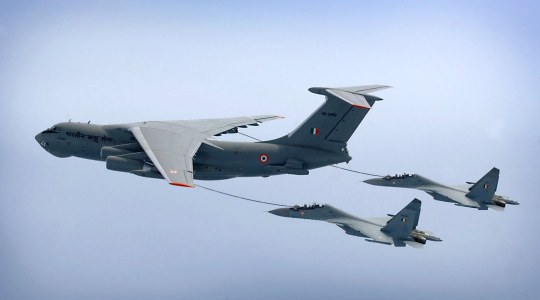
Il-78 Midas and Su-30MKI.
These endless complications ?? about military parts for India were exacerbated after the disintegration of the Soviet Union in the early 1990s, after which many defense manufacturing units and factories fell under the limits of separatist republics such as Ukraine, which were enemies of Moscow. This generated not only a shortage of spare parts, making them difficult, if not impossible, to obtain, but also prohibitively expensive, as some of the production lines had closed due to little or no demand.
This also resulted in the entire Indian army, including the IAF, obtaining spare parts of dubious quality from the parallel market that, in some cases, even led to equipment failures, for which responsibility was rarely attributed.
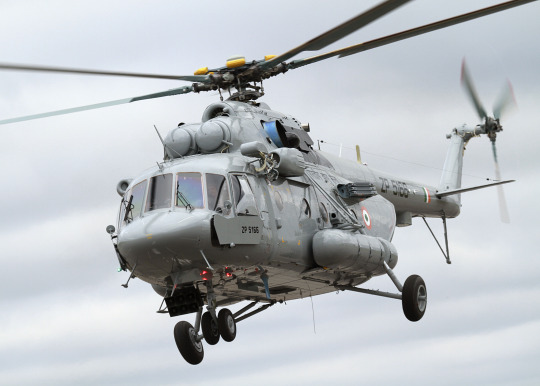
One thousand Mi-17 of the Indian Army.
Despite Air Marshal Singh's braggart about the imminent resumption of the IAF's uninterrupted military trade with Russia, he also does not seem to take into account the dual sanctions of the Swords of Damocles that hang over force, which also include the Act to Combat the Opponents of America through US Sanctions (CAATSA
This 2017 law, which followed Russia's annexation of Crimea in 2014 and Moscow's alleged interference in the U.S. elections two years later, directly threatens the recent implementation of the IAF of the first of five Almaz-Antey S-400 Triunf S-400 air defense missile systems that India had acquired at the end of 2018 for $5.5 billion
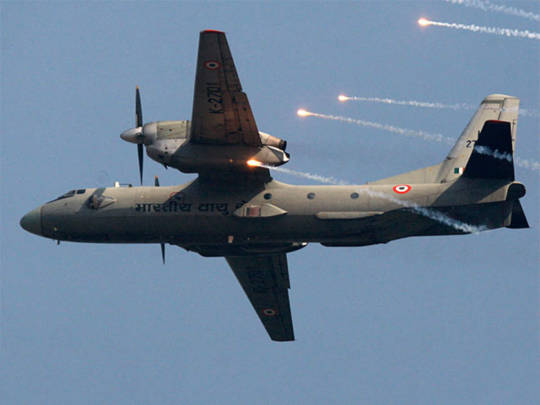
Antonov AN-26.
So far, CAATSA has been invoked against China and Turkey for installing S-400 systems, but not against Delhi, which seems to have received (for now) a silent resignation by Washington. Perhaps in this case, too, the military of India, especially the IAF, and its political and bureaucratic establishment are discreetly betting on administering these calamities collectively, via jugaad or the rope trick, or possibly even both.
Source: The Wire
Tags: Military AviationIAF - Indian Air ForceMiG-29UPGRussiaSukhoi Su-30MKI FlankerWar Zones - Russia/Ukraine
Embraer promotes its Defense & Security portfolio at the World Defense Show in Saudi Arabia
Fernando Valduga
Aviation photographer and pilot since 1992, he has participated in several air events and operations, such as Cruzex, AirVenture, Dayton Airshow and FIDAE. He has works published in specialized aviation magazines in Brazil and abroad. Uses Canon equipment during his photographic work in the world of aviation.
Cavok Brazil - Digital Tchê Web Creation
16 notes
·
View notes
Text
Good day ladies and gentlemen. Hope 2021 brings about a lot of happiness to everyone.
This is my first ever blog, and I have chosen an unusual topic to write about. Unusual, because us mortals, seldom tread on subjects pertaining to the defense of our nation, India.
We are all aware by now that Indian Air Force has inducted the French Rafale fighter jets into it’s arsenal. Recently there was a huge hue and cry regarding the induction of 36 Rafales purchased from Dassault Aviation, France. So by now most of us have heard the name at least.
Today, I take you back in time when the original tender for the acquisition of 126 multi role combat aircraft was floated in 2008 by the then UPA Government. Why is it that the IAF was in a sudden rush to procure such a huge number of high end platforms.
The defence of this country with its huge land and sea borders have generally been given a step motherly attitude by successive governments. Even though we have the world’s 4th largest armed forces in terms of manpower, the weapons platforms that are used in all the three services are a bit dated. More so with the IAF.
Till date the IAF uses 1960-70s era platforms like the MIG 21 Fishbeds and MIG 23/27 Flogger aircrafts along with a plethora of other jets like the SEPECAT Jaguar and the Dassault Mirage 2000H . Recently our air arsenal received a huge boost with the advent of the Sukhoi Su 30mki multi role fighters. These along with the MIG 29s form the main strike platforms of our air force. But the MIG 21 and 23/27 are nearing the end of their tenure, albeit heavy upgradations. In fact the MIG 23/27 has already been retired from service.
To keep a healthy plausible deterrent against our neighbours like Pakistan and China, with whom we have less than cordial relations, the IAF needs a minimum of 44 squadrons of multi role fighters. But the inventory has been depleted severely and the absolute minimum requirement of 39.5 squadrons are currently not being met.
The initial objective of this tender was to procure 20 ton class of fighters like the Mirage 2000s, which had performed admirably during the Kargil conflict of 1999. But due to the order of the Dassault Rafales from the French government, and the lack of orders from foreign buyers for the Mirage jets, Dassault Aviation had already decided to close down the production lines for the Mirage.
This led to the IAF taking off the 20 tonnes MTOW (Maximum Take Off Weight) limit on procurement of fighters. The MMRCA (Medium Multi Role Combat Aircraft) was seen as a platform between the HAL developed LCA (Light Combat Aircraft) and the heavy birds like the Su 30MKI .
There were 6 main contenders for the race for the 126 MMRCA deal (worth around USD 7.7 billion at that time). The contenders were: Dassault Rafale, Eurofighter Typhoon, Boeing F/A18 E-F Super Hornet, Lockheed Martin F 16IN, Saab JAS 39 Gripen and the MIG 35.
Now let’s get a little technical on these mean machines.
Mikoyan MIG 35: India is currently operating the MIG 29SM and the MIG 29K naval versions. The MIG 35 is but the elder brother of the same aircraft. It of course processes a more advanced avionics platform with the ZhUK AE AESA (Active Electronically Scanned Array) radar, OLS – UEM IRST (Infra Red Search and Track) systems, OLS-K Laser Targetting pods etc, it is basically the same platform that IAF already operates. Weapons wise it would not bring about a massive improvement to the IAF arsenal. It would operate the brilliant AA -11 Archer WVR AAM (Within Visual Range Air to Air Missile) and AA-12 BVR ( Beyond Visual Range) AAM. But these are already there with the IAF. Plus the ZhUK AE AESA radar was not yet operational and had a lot of deficiencies at the time it was displayed at Aero India 2007. The IAF was not too keen in the MIG 35 jets although it has a technical knowhow regarding MIG handling. Despite the fact that Russia was keen on complete ToT ( Transfer of Technology) to India, the IAF did not want to put all its eggs in one basket. It wanted a platform from a completely different source but a reliable one.
SAAB GRIPEN : the SAAB Gripen is currently one of the most advanced single engine fighters in operation around the world. It stands at 17 tonnes and can be classified as a light combat aircraft. Although the Gripen NG, which was offered to India was substantially heavier. The NG version offered a platform with increased internal fuel capacity and an engine with 35% more thrust that the original. The aircraft has superb cockpit ergonomics and magnificient handling and maneuverability. All Gripen aircrafts are digitally linked to each other and can stealth fire its munitions without giving away its position. This is due to the fact that all the Gripens are linked and 1 aircraft can fire its missiles/ smart bombs without lighting up its own FCR (Fire Control Radar). It also comes with a very advanced DAS(Defensive Aids Subsystem). The only point where its lacking is the fact that it does not have the AESA radar, which was one of the major factors in procuring these aircrafts. Moreover the Gripen lacked an advanced IRST suite, although its DAS is very advanced. The weapons platform for Gripen includes U.S made AIM 120 AMRAAM (Advanced Medium Range Air to Air Missile) along with Israeli Python and Derby systems. The main problem that may arise is that the U.S may not approve of the use of such high tech missiles. Moreover SAAB’s TOT cannot be certain as many of the equipment on board are from various foreign manufacturers.
LOCKHEED MARTIN F16 IN – the F16 is one of the most popular single engine fighters of the world and it is absolutely a majestic aircraft. The F16 IN is based on the F16 Block 60 which was supplied to the U.A.E. although the original F16 was intended as a lightweight daylight fighter at the time of its inception, it has come a long way since then, and is currently the backbone of a majority of air forces in the world. It is highly agile and maneuverable and carries a diverse range of very advanced weapons systems. It has both BVR and WVR capabilities and is also equipped with the Northrop Gruman AESA radar. It is still a brilliant aircraft even though its ageing.
One of the main requirements for the IAF was longer range and heavier weapons carrying capability. This was provided for by the F16IN in the form of CFT (Conformal Fuel Tanks). Once these tanks are fitted to the aircraft its range and weapons load increases but its agility and maneuverability decreases rapidly. This factor plus the age of the mainframe of the aircraft made the IAF a little vary regarding the purchase of the latest variant of the F16.
F/A 18 E-F Super Hornet : This is the latest offering from Boeing. It is a state of the art modern jet equipped with the much vaunted AESA radar and a weapons platform which is second to none. It has both BVR and WVR capabilities, with air superiority as well and secondary ground attack capabilities. Its carries the AIM 120 AMRAAM missile for BVR purposes and the AIM 9X for WVR purposes. It also carries a variety of precision guided munitions. As for its agility and handling, it is based on the super maneuverable F 15 Eagle and has some of the best handling capabilities of all aircrafts. Its avionics suite includes the ATFLIR (Advanced Tactical Forward Looking Infra Red) systems and a highly advanced DAS called the IDECM (Integrated Defensive Electronic Counter Measures). This along with RWR (Radar Warning Receiver) a MAWS (Missile Approach Warning System), electronic jammers and counter measure dispensers makes it a formidable aircraft.
But in case of both these aircrafts there is but one huge glaring deficiency. They are both manufactured by United States. As of now India and United States are on extremely friendly terms but this may change due to circumstances. As has been previously demonstrated in 1998, right after the Pokhran 2 nuclear tests conducted by India, the U.S will not think twice before putting on trade and arms supply embargos on India. More over the TOT for these aircrafts are uncertain, though Lockheed Martin is interested in setting up its plant in India, its not sure how much TOT we may get on the F/A 18 E-F Super Hornet, as its currently being used extensively by the USAF and the USN.
EUROFIGHTER TYPHOON : The TYPHOON is built by a consortium of 4 European countries – UK, Germany, Italy and Spain. The version requested by IAF is the Tranche 3 of the TYPHOONS. This will meet its air superiority and ground attack capabilities. The TYPHOON is a majestic craft . It has an unstable design which makes it highly aero dynamic. It incorporates digital fly by wire technology and is a super maneuverable aircraft. It has easy handling and its flight control system automatically prevents it from going into dangerous envelopes where it may stall or spin. It has an extremely advanced avionics suite with a highly developed IRST system (possibly the best) in the PIRATE. The aircraft also incorporates a FLIR thermal imager for passive search and scan. The DAS on board this aircraft is highly capable too with RWR, MAWS and counter measure systems all incorporated. This gives the pilot a great situational awareness regarding the threats to his aircraft. The only problem with the Eurofighter TYPHOON is that it is yet to accommodate an AESA radar, which is supposedly in the process of development. As for the weapons, the TYPHOON uses the AIM 120 AMRAAM, AIM 9L ASRAAM , IRIS-T (for WVR) as well as the Meteor systems. Other than air superiority weapons it carries a variety of precision guided munitions and SEAD (Suppression of Enemy Air Defense) weapons. However the weapons on board this powerful jet is out sourced from various countries and this may become a problem for India in future. Also it must be taken into account that TOT in its complete format may not be available to India as there is a consortium of different countries producing this aircraft, and all may not agree to the terms.
DASSAULT RAFALE : The RAFALE (squall) is the delta wing fighter on offer from one of India’s biggest allies – France. IAF already operates the Mirage 2000 aircrafts and although it’s ageing we are well aware of its capabilities. The RAFALE was developed to replace the SEPECAT Jaguars and the Super Etendard aircrafts of the French air force and navy. The Rafale is a state of the art dual engine fighter and is currently equipped with the RBE2 AA AESA radar and the optronique secteur frontale IRST systems, which operate in both medium wave infra red and long wave infra red spectrums is touted to be the best in the world. It is designed to be unstable so as to give it extremely high agility in air combat. It has an extremely well developed DAS with full 360 degrees coverage and excellent cockpit ergonomics. The aircraft comes in with 2 superb but expensive AAMs in form of MICA IR with its IIR sensor and the MBDA Meteor BVRM. It can carry the Damocles targeting pod and a plethora of air to ground and SEAD weapons. The Rafale also has the co-operative targeting facility whereby it can stealth fire its munitions. Overall it is a masterful aircraft and can pose as a threat to any and every adversary we may face in the near future.
It must also be borne in mind that India and France has very good relations and has been a strong ally for each other since 1947. Also IAF has operated and still operates Dassault Aviation aircrafts and have the basic necessary infrastructure for future inductions.
So, ladies and gentlemen these were the contenders for the much touted MMRCA deal for procurement of 126 multi role aircrafts for the Indian Air Force. I hope that you have enjoyed reading this small article that I am putting up today . All facts regarding these aircrafts are true to my knowledge and have been gathered from different sources on the internet. Hope you have a good read.
3 notes
·
View notes
Text
The Sringer Air Show Is Back After 14 Years And Fascinates People.
Over Srinagar barked on Sunday morning, displaying adrenaline pumping operations during an air show where Chinook fighters and helicopters took place 14 years later.
Know About Sushant Gupta Defsys Solutions Private Limited.
Air force bases, Srinagar, and government-sponsored air shows are part of an ongoing celebration, officials said.

The main purpose of this program was to encourage and motivate young people in the Kashmir Valley to join the Indian Air Force and promote tourism in the region under the slogan "Give wings to dreams."
When team members opened the parachute to display various formations, the Indian flag, IAF flag, and Akash Ganga flag were flying in the sky.
The team, which holds several national and international records in its name, also formed a three-color formation of three people in the air.
After the parachute jump, three Sukhoi Su-30MKI jets soared into the sky. People were fascinated by the formation of Trishul, where the rays of light smoked and roared in the air, turning, rolling and turning across Dal Lake.
1 note
·
View note
Text
Meet Avani Chaturvedi, IAF's First Woman Fighter Jet Pilot to Fly Sukhoi Su-30MKI in Aerial Wargame Abroad
Squadron Leader Avani Chaturvedi, was part of the IAF contingent that participated in a 16-day air combat exercise with the Japan Air Self Defence Force (JASDF) at the Japanese airbase of Hyakuri. source https://zeenews.india.com/aviation/meet-avani-chaturvedi-iafs-first-woman-fighter-jet-pilot-to-fly-sukhoi-su-30mki-in-aerial-wargame-abroad-2569772.html
View On WordPress
0 notes